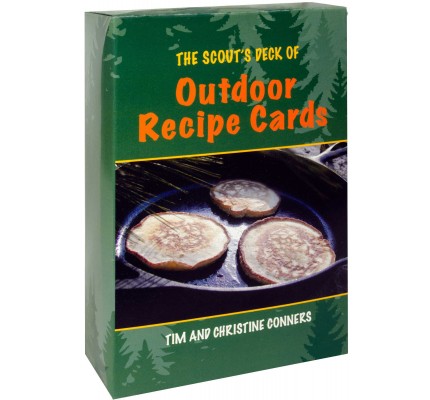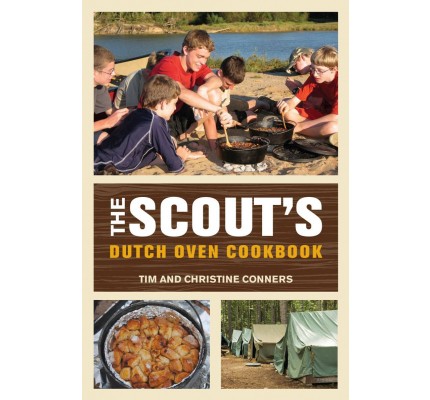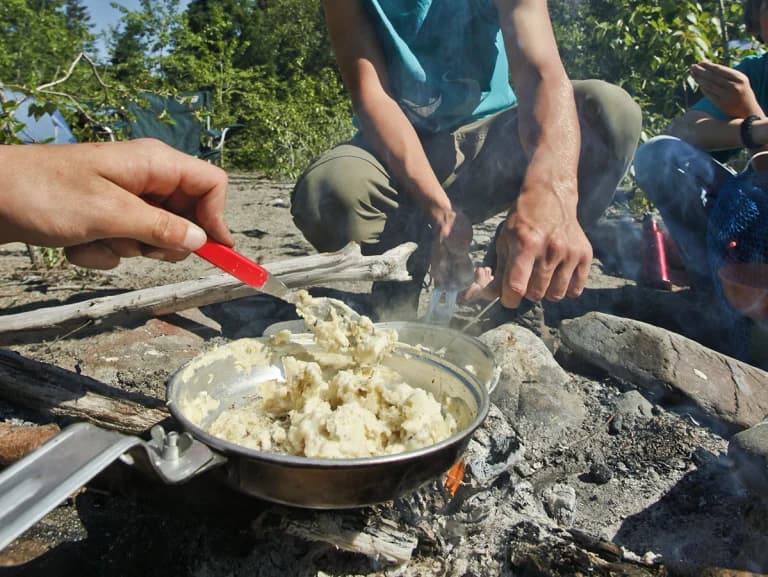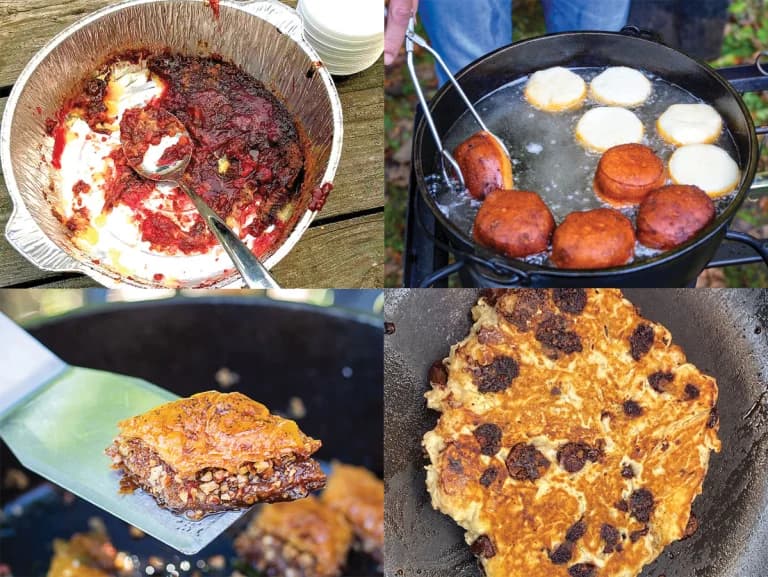Cooking Merit Badge
 Eagle Required
Eagle Required
Cooking
Merit Badge
Boy Scouts of America Merit Badge Hub
Boy Scouts of America
Merit Badge Hub

Requirement Updates 2024
This Merit Badge’s Requirements have recently been updated in 2024 Scouts BSA Requirements (33216). Please read more about “Requirements” on the Merit Badge Hub homepage.
Cooking Merit Badge Overview
The Cooking merit badge introduces principles of cooking that can be used both at home or in the outdoors. Scouts who earn this badge will learn about food safety, nutritional guidelines, meal planning, and methods of food preparation, and will review the variety of culinary (or cooking) careers available.
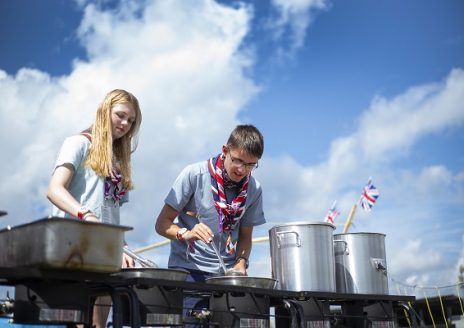
Cooking Merit Badge Requirements
The requirements will be fed dynamically using the scout book integration
1. Health and safety. Do the following:
- (a) Explain to your counselor the most likely hazards you may encounter while participating in cooking activities and what you should do to anticipate, help prevent, mitigate, and respond to these hazards.
- (b) Show that you know first aid for and how to prevent injuries or illnesses that could occur while preparing meals and eating, including burns and scalds, cuts, choking, and allergic reactions.
- (c) Describe how meat, fish, chicken, eggs, dairy products, and fresh vegetables should be stored, transported, and properly prepared for cooking. Explain how to prevent cross-contamination.
- (d) Discuss with your counselor food allergies, food intolerance, and food-related illnesses and diseases. Explain why someone who handles or prepares food needs to be aware of these concerns.
- (e) Discuss with your counselor why reading food labels is important. Explain how to identify common allergens such as peanuts, tree nuts, milk, eggs, wheat, soy, and shellfish.
2. Nutrition. Do the following:
- (a)
Using the MyPlate food guide or the current USDA nutrition model, give five examples for EACH of the following food groups, the recommended number of daily servings, and the recommended serving size:
(1) Fruits
(2) Vegetables
(3) Grains
(4) Proteins
(5) Dairy - (b) Explain why you should limit your intake of oils and sugars.
- (c) Track your daily level of activity and your daily caloric need based on your activity for five days. Then, based on the My Plate food guide, discuss with your counselor an appropriate meal plan for yourself for one day.
- (d) Discuss your current eating habits with your counselor and what you can do to eat healthier, based on the MyPlate food guide.
- (e) Discuss the following food label terms: calorie, fat, saturated fat, trans fat, cholesterol, sodium, carbohydrate, dietary fiber, sugar, protein. Explain how to calculate total carbohydrates and nutritional values for two servings, based on the serving size specified on the label.
3. Cooking basics. Do the following:
- (a) Discuss EACH of the following cooking methods. For each one, describe the equipment needed, how temperature control is maintained, and name at least one food that can be cooked using that method: baking, boiling, broiling, pan frying, simmering, steaming, microwaving, grilling, foil cooking, and use of a Dutch oven.
- (b) Discuss the benefits of using a camp stove on an outing vs. a charcoal or wood fire.
- (c) Describe for your counselor how to manage your time when preparing a meal so components for each course are ready to serve at the correct time.
Note: The meals prepared for Cooking merit badge requirements 4, 5, and 6 will count only toward fulfilling those requirements and will not count toward rank advancement or other merit badges. Meals prepared for rank advancement or other merit badges may not count toward the Cooking merit badge. You must not repeat any menus for meals actually prepared or cooked in requirements 4, 5, and 6.
4. Cooking at home. Using the MyPlate food guide or the current USDA nutrition model, plan menus for three full days of meals (three breakfasts, three lunches, and three dinners) plus one dessert. Your menus should include enough to feed yourself and at least one adult, keeping in mind any special needs (such as food allergies) and how you keep your foods safe and free from cross-contamination. List the equipment and utensils needed to prepare and serve these meals.
Then do the following:
Then do the following:
- (a) Find recipes for each meal. Create a shopping list for your meals showing the amount of food needed to prepare for the number of people you will serve. Determine the cost for each meal.
- (b) Share and discuss your meal plan and shopping list with your counselor.
- (c) Using at least five of the 10 cooking methods from requirement 3, prepare and serve yourself and at least one adult (parent, family member, guardian, or other responsible adult) one breakfast, one lunch, one dinner, and one dessert from the meals you planned.*
- (d) Time your cooking to have each meal ready to serve at the proper time. Have an adult verify the preparation of the meal to your counselor.
- (e) After each meal, ask a person you served to evaluate the meal on presentation and taste, then evaluate your own meal. Discuss what you learned with your counselor, including any adjustments that could have improved or enhanced your meals. Tell how planning and preparation help ensure a successful meal.
5. Camp cooking. Do the following:
- (a) Using the MyPlate food guide or the current USDA nutrition model, plan a menu that includes four meals, one snack, and one dessert for your patrol (or a similar size group of up to eight youth, including you) on a camping trip. These four meals must include two breakfasts, one lunch, and one dinner. Additionally, you must plan one snack and one dessert. Your menus should include enough food for each person, keeping in mind any special needs (such as food allergies) and how you keep your foods safe and free from cross-contamination. List the equipment and utensils needed to prepare and serve these meals.
- (b) Find or create recipes for the four meals, the snack, and the dessert you have planned. Adjust menu items in the recipes for the number to be served. Create a shopping list and budget to determine the per-person cost.
- (c) Share and discuss your menu plans and shopping list with your counselor.
- (d) In the outdoors, using your menu plans and recipes for this requirement, cook two of the four meals you planned using either a camp stove OR backpack stove. Use a skillet over campfire coals OR a Dutch oven for the third meal, and cook the fourth meal in a foil pack OR on a skewer. Serve all of these meals to your patrol or a group of youth.**
- (e) In the outdoors, using your menu plans and recipes for this requirement, prepare one snack and one dessert. Serve both of these to your patrol or a group of youth.**
- (f) After each meal, have those you served evaluate the meal on presentation and taste, and then evaluate your own meal. Discuss what you learned with your counselor, including any adjustments that could have improved or enhanced your meals. Tell how planning and preparation help ensure successful outdoor cooking.
- (g) Lead the clean-up of equipment, utensils, and the cooking site thoroughly after each meal. Properly store or dispose unused ingredients, leftover food, dishwater and garbage.
- (h) Discuss how you followed the Outdoor Code and no-trace principles when preparing your meals.
6. Trail and backpacking meals. Do the following:
- (a) Using the MyPlate food guide or the current USDA nutrition model, plan a meal for trail hiking or backpacking that includes one breakfast, one lunch, one dinner, and one snack. These meals must consider weight, not require refrigeration and are to be consumed by three to five people (including you). List the equipment and utensils needed to prepare and serve these meals.
- (b) Create a shopping list for your meals, showing the amount of food needed to prepare and serve each meal, and the cost for each meal.
- (c) Share and discuss your meal plan and shopping list with your counselor. Your plan must include how to repackage foods for your hike or backpacking trip to eliminate as much bulk, weight, and garbage as possible.
- (d) While on a trail hike or backpacking trip, prepare and serve two meals and a snack from the menu planned for this requirement. At least one of those meals must be cooked over a fire, or an approved trail stove (with proper supervision).**
- (e) After each meal, have those you served evaluate the meal on presentation and taste, then evaluate your own meal. Discuss what you learned with your counselor, including any adjustments that could have improved or enhanced your meals. Tell how planning and preparation help ensure successful trail hiking or backpacking meals.
- (f) Explain to your counselor how you should divide the food and cooking supplies among the patrol in order to share the load. Discuss how to properly clean the cooking area and store your food to protect it from animals.
7. Food-related careers. Find out about three career opportunities in cooking. Select one and find out the education, training, and experience required for this profession. Discuss this with your counselor, and explain why this profession might interest you.
* The meals for requirement 4 may be prepared on different days, and they need not be prepared consecutively. The requirement calls for Scouts to plan, prepare, and serve one breakfast, one lunch, and one dinner to at least one adult; those served need not be the same for all meals.
** Where local regulations do not allow you to build a fire, the counselor may adjust the requirement to meet the law. The meals in requirements 5 and 6 may be prepared for different trips and need not be prepared consecutively. Scouts working on this badge in summer camp should take into consideration foods that can be obtained at the camp commissary.

Get the Cooking Merit Badge Pamphlet
Scouts use the Cooking Digital Merit Badge Pamphlet to earn the Cooking merit badge, which introduces principles of cooking that can be used both at home or in the outdoors.

Shop Cooking Merit Badge Products
As the exclusive retailer of the BSA, 35% of every Scout Shop purchase supports the future of Scouting.
Discover more about "Cooking"

Mike Holcombe has seen Scouts who were afraid to stir soup. Chip Goss has watched Scouts turn rice pilaf into charcoal, despite his frequent reminders to check the pot. Both have eaten enough half-cooked pancakes and overdone burgers to last a lifetime. This summer, the two Scouters teamed up to lead the inaugural Chef Prep camp at the Connecticut Rivers Council’s June Norcross Webster Scout Reservation. Their goal was to help Scouts earn the Eagle-required Cooking merit badge and acquire the skills they need to thrive in camp, at home and in a commercial kitchen. Scouting caught up with them to learn the secrets of culinary counseling. Assume Nothing
Goss, a trained chef and food service director at Connecticut River Academy, can tell at a glance how many cups of water are in a pan or determine with a taste what’s missing from a dish. His Scouts, on the other hand, might not know a saucepan from a stockpot. He’s careful not to assume they know their way around a kitchen. “As a chef, I have to remind myself that not everybody is practiced in holding their hand in a certain way and getting a perfect teaspoon or a perfect tablespoon of salt or pepper,” he says. To make sure Scouts are ready for the Cooking merit badge, Holcombe, a longtime Scouter, recommends they reach First Class rank first. That way, he says, “they’ve had some exposure to dealing with food; they’ve had to cut it, they’ve had to stir it, they’ve had to put it on the fire. If they come in cold turkey, I think you’re just making it harder on them.” Harness Technology
While most Scout cooking is decidedly low-tech, Goss says smartphones can make cooking easier and more interesting. Rather than hand Scouts a cookbook, for example, he’ll have them look up recipes on their phones. And he knows using a timer app might prevent a Scout from turning his spaghetti into wallpaper paste. “As leaders, we have to recognize that sometimes the technology is there for the good,” Goss says. Make It Real
Each time a Scout cooks for the badge — whether at home, in camp or on the trail — he is supposed to ask those he has served to evaluate his efforts. To make this process more real in camp, Holcombe invites staff members to lunch each day, including the camp nurse, the office clerk and assorted staffers he affectionately calls “the vultures.” Not surprisingly, the Scouts perform better when people are counting on them. “I think they take a lot of pride in it,” Holcombe says. “It’s like, ‘I made this.’ ” Prepare Them for Life
When he got his first cooking job, Goss knew how to cook, but he didn’t know the right terminology, which meant he started as a line cook instead of a master cook. So he emphasizes both techniques and terms when he teaches the badge. But he says the badge is important whether Scouts go pro or not. “Cooking is the one merit badge everybody can use,” he says. “Don’t treat it as just another merit badge. Treat it as a tool for living.”

When Avery Moore isn’t volunteering as Scoutmaster of Troop 11 in Rocky Mount, N.C., you can find him helping out at a local pediatric burn survivor aftercare program. It was during a virtual meeting for the latter that he discovered a need that could be met by the former. “Since COVID-19 has impacted the globe the way it has,” Moore says, “the burn units have been bombarded with pediatric burn patients, all of them with a similar story: They were trying to cook when no one was around, and something went horribly wrong.” Then, a debate arose with an answer that would be obvious for anyone involved in Scouting. “Very simply, they just wanted to know if there were any youth-serving organizations that teach life skills to youth like cooking, first aid, safety, fire prevention … and the list could go on,” Moore says.

Chow time is one of our favorite things about camping. Whether it’s a steamy pot of cheesy pasta or warm biscuits fresh out of the Dutch oven, good food makes for good times on the trail. Proper nutrition is key when you’re hiking and spending time in the outdoors because it nourishes your body and your spirits. But cooking takes a little work and the right kind of gear. Just try to damage the BSA STAINLESS STEEL MESS KIT ($19.95, scoutshop.org) — it’s not likely. This durable kit comes with everything you need. It’s made from 18/8 stainless steel with a rustproof finish. The set includes a 1-liter pot, 6.3-inch frying pan, 5.9-inch plate and 12-ounce cup. The pot and pan have folding silicone-coated handles, and all the pieces nest together and fit in a mesh stuff sack. Coolest feature: You can use them cooking over a campfire or coals, and the pan can double as a pot lid. 1 lb. 1 oz.
MESS KITS
The term “mess kit” might seem old-fashioned. (Brief history lesson: “Mess” originally referred to a portion of food. As long ago as the 15th century, “mess” also meant a group of four people who sat to eat together.) Today’s camping and backpacking kits for cooking and eating offer a functional, neat modernization for a piece of timeless gear. Often, the pieces (a cook pot, bowl, cup, etc.) nest together in a compact package that fits easily inside a backpack. These packages are generally lighter weight and more affordable than buying each piece individually. And with a mess kit, before each trip you can pick and choose exactly which pieces of the kit you want/need on the trail. Expect to pay from $10 to $30 for a basic kit. Want a mess kit that’s environmentally less messy? The LIGHT MY FIRE MESSKIT BIO ($24.95, lightmyfire.com) is made from reusable bio-based plastics. It includes a plate, deep-bottomed bowl, collapsible cup and serrated spork. Everything nests, and the kit serves as a lunchbox. 7.2-by-3.5-by-2.3 inches, 9.1 oz.
BOWLS, SPOONS, CUPS
The bare minimum you need for eating on most outings is a bowl, a spoon and a cup. An unbreakable bowl works well for everything you’ll eat, and a spoon (or spork) will help you shovel almost anything into your face. Arguably the coolest innovation in backpacking cook kits in years, the SEA TO SUMMIT X-SET 31 ($109.95, seatosummitusa.com) features a 2.8-liter pot, two 22-ounce bowls and two 16.2-ounce mugs, all of which have flexible, food-grade silicone walls that collapse. The entire nested kit measures about an inch and a half tall. The collapsible walls on the pot, bowls and mugs are rigid when assembled, avoiding spills. The mug walls have measurement markings. The pot’s aluminum base cooks evenly. Bowls, mugs and a collapsible pour-over coffee dripper can be purchased separately and nested into the larger kit or carried individually when backpacking. 1 lb. 5 oz.
STOVES
It’s not always best or even possible to cook by campfire. Open fires might be prohibited where you’re camping, maybe dry firewood is nowhere to be found, or perhaps you just want to have less impact on Mother Earth. That’s where backpacking stoves come in. We recommend two basic kinds: Canister (or cartridge) stoves: Small, lightweight and affordable stoves that screw onto canisters of pressurized gas (about $3 each). They’re easy to use and pretty much maintenance-free, but empty canisters aren’t refillable or recyclable and must be packed out. Liquid-fuel stoves: Compact stoves that use refillable fuel bottles usually containing white gas or propane. They are extremely reliable and work well even in frigid temperatures. Liquid-fuel stoves are generally more expensive, slightly more complicated, and require regular maintenance and cleaning. But they’re also easier on the planet (and, eventually, your wallet) because the fuel bottles are refillable. The GSI BUGABOO MESS KIT ($29.99, gsioutdoors.com) provides the implements for cooking and eating: a 1-quart pot, 7.5-inch pan, 6-inch polypropylene bowl, 12-ounce polypropylene cup and a gripper — all nest and stow in a mesh stuff sack. The kit’s aluminum disperses heat to cook evenly, and each piece has two layers of nonstick coating for scratch resistance. In all, a good value for a young camper, if a bit heavy for backpacking. 1 lb. 0.7 oz.
COOK POTS
On most outings, pots and pans are shared to save both weight and money. Pots can be made of everything from sturdy stainless steel to aluminum and super-light titanium. Stainless steel is the most durable and heaviest; aluminum is affordable and lightweight but not so durable; and titanium cookware is durable and super-light but very expensive. Prices range from $15 to $100, and some come with a nonstick coating. Always look for a pot that comes with a lid, because it speeds up boiling times and often can be flipped over and used as a frying pan. For two hungry campers, the MSR 2-PERSON MESS KIT ($34.95, msrgear.com) offers a simple lightweight kit: two plastic insulated mugs, two deep dish bowls and two folding sporks. The components nest and store in a mesh bag, measuring just more than 5-by-5 inches, making the kit ideal for backpacking. 13 oz.
DUTCH OVENS
A camping classic for decades, the Dutch oven is a heavy cast-iron pot with a lid. Though much too heavy for backpacking, this is a must-have for base camps and car-camping trips. Placing the oven over a campfire, you can easily fry fish, cook stews and beans, and bake pies, bread and cobblers. A new Dutch oven must always be seasoned first, rubbed inside with grease or butter to make it nonstick and protect the metal from rusting.

It’s important to eat balanced meals, but sometimes it’s nice to satisfy your sweet tooth. Here are four tasty recipes to try. Have a favorite dessert recipe? Send it to us! OWASIPPE SOUP Last summer at Owasippe Scout Reservation in Michigan, Matthew Hanson with Troop 41 of Glen Ellyn, Illinois, won a cooking contest with this recipe. Ingredients One 20-ounce can crushed pineapple in juice
One 21-oz. can cherry pie filling
1 box chocolate cake mix
¾ cup butter, melted
Directions Spread the crushed pineapple and its juice into a 12-inch Dutch oven. Spread the cherry pie filling on top of the crushed pineapple. Evenly spread cake mix over both layers, and then pour melted butter on top. Cook in Dutch oven 40-45 minutes with about 15 coals on top and 10 on the bottom. Serve. CAVE DOUGHNUTS After exploring the Sullivan Cave in Indiana, Scouts with Troop 797 of Utica, Illinois, made this tasty treat. Ingredients 1 gallon vegetable oil
Pre-made biscuits
Powdered sugar
Cupcake icing in a can
Directions Fill a pot two-thirds full with oil. Heat it until dough turns lightly brown when it’s placed in; this might take a couple of tests. Place balls of biscuit dough in the oil and let them cook for about 2 minutes, flipping after about 1 minute. Then remove the cooked dough with tongs and roll them in the powdered sugar. Inject the doughnuts with the icing. Serve DUTCH OVEN BAKLAVA Scouts with Troop 1911 of Missoula, Montana, cook this treat annually at summer camp. Ingredients 24 sheets phyllo dough (a special thin dough, also in stores as filo and fillo)
1 cup butter, melted
1½ cups finely chopped pecans
2 tablespoons sugar
1 teaspoon cinnamon
Lemon honey syrup: 1½ cups sugar
¾ cup water
½ teaspoon lemon juice
1 tablespoon honey
Directions Prepare honey syrup by combining all ingredients and bringing to a boil for 1 minute. Set aside to cool. Melt the butter. Mix pecans, sugar and cinnamon; set aside. Generously butter the bottom of a 12-inch Dutch oven. Lay 1 sheet of phyllo dough in the bottom of the Dutch oven. Butter the top, beginning at the edges and working toward the center. Repeat this step until you have placed eight sheets of phyllo dough, buttering each layer. Sprinkle half of the nut mixture evenly over the phyllo dough. Place eight more sheets of phyllo dough on top of nut mixture, buttering between each layer. Sprinkle the remaining nut mixture on top. Repeat with eight more sheets of phyllo dough, buttering each layer. Drizzle any remaining butter on the top. Cut into diamond-shaped pieces without cutting through the bottom layer of phyllo dough. Place the lid on the Dutch oven and bake at 350 degrees (eight coals on bottom, 16 on top) for 35-40 minutes or until lightly golden. Remove from heat and pour the honey syrup over the baklava. Serve. S’MORES PANCAKES The Scouts of Troop 129 of Anchorage, Alaska, make this breakfast meal the first morning of summer camp every year. Ingredients (feeds 4) 2 cups pancake mix
About 1½ cups water
1 sleeve of graham crackers, crushed
2 cups chocolate chips
1 container marshmallow fluff
Directions Preheat a pan on medium-high heat and grease with butter. Combine the pancake mix with water, and then stir in the crushed graham crackers and chocolate chips. Place mixture on the pan in desired size and shape. Cook until golden brown on both sides. Remove from the pan and top with marshmallow fluff and any additional toppings of your choosing. Serve.




